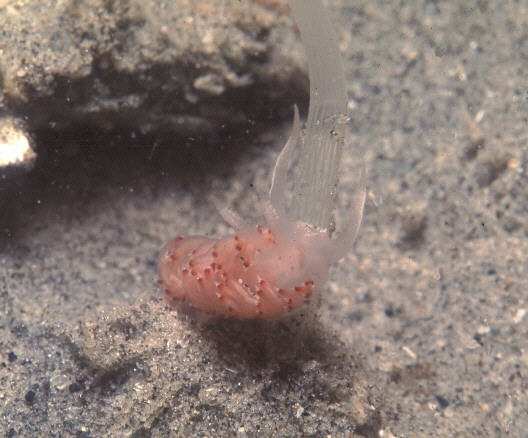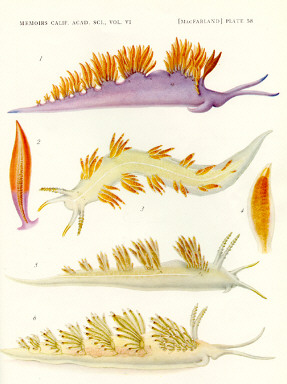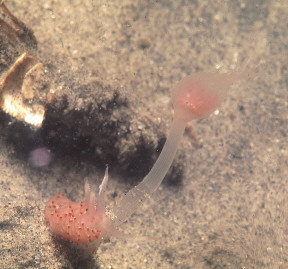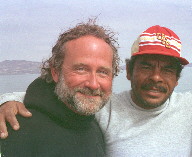
Flabellina pricei
Flabellina pricei (MacFarland, 1966)

Flabellina pricei is distinguished by its whitish body coloration. The slender cerata are arranged in distinctive rows; each ceras is yellow-creamish colored, with a white tip and a subapical brown band. Frank Mace MacFarland named this species posthumously in 1966. On the bottom of Plate 58 of MacFarland's significant monograph, we see MacFarland's portrayal of a "A rare species." In the text, under Habitat, Dr. MacFarland (and the editors) wrote, "Coryphella pricei has been taken in relatively small numbers in and near Monterey Bay in rocky tidepools, well out beyond extreme low-water mark, upon bryozoan or hydroid colonies, crawling upon submerged algae, or floating at the surface of the quiet pools. Rare." This species gives us an excellent example of the amount of information available to nudibranch researchers before the advent of scuba diving. They were restricted to the intertidal region, and primarily described the species' occurrences as "underneath rocks." Hence many species were considered rare. However, with the advent of subtidal scuba exploration, we have found that many species are really fairly common and predictable. They have preferred habitats and prey not in the intertidal rock-rolling area. Since its original description, the range of this species has been expanded to the north (to Ketchikan, Alaska, by Millen, (1989) and to the south (to La Jolla, California, by Bertsch and Smith, 1983). Between these extreme range records, other investigators have described shorter extensions (Gosliner & williams, 1970, Lamber, 1976, and Sphon, 1972). Previous records of this species mention only its distribution or anatomy. However, our records of Flabellina pricei from the subtidal La Jolla shores/canyon region, indicate that the species may be more common than MacFarland reported. |

Mike Miller and I have found this species in the sand flats of La Jolla Shores (and Canyon). The accompanying photograph shows its predation upon the hydrozoan Corymorpha palma (a typical sand dweller). In the past 6 years I have seen Flabellina pricie in the La Jolla Canyon during the months of September, January, and February (24 January 1994; 13 February 1994; 12 February 1995; 1 September 1996, with eggs; 10 September 1997). Dr. MacFarland considered this species rare because he did not have the advantage of scuba diving in the La Jolla shores region or other subtidal habitats. Sand and corymorpha seem to be the preferred habitat for this species, where it is no longer just "rare." |
A final note: who was Mr. Price? This would be an intriguing side-note to our nudibranch of the week.
Bertsch, Hans, and Tom Smith. 1983. Range extensions of three opisthobranch mollusks to the San Diego-La Jolla (California) Ecological Reserve. The Veliger 26 (1): 69-70.
Gosliner, Terrence M., and Gary C. Williams 1970. The opisthobranch mollusks of Marin County, California. Veliger 12 (2): 175-280.
Lamber, P. 1976. Records and range extensions of some northeastern Pacific opisthobranchs (Mollusca: Gastropoda) . Canad. J. Zool. 54: 293-300.
MacFarland, Frank Mace. 1966. Studies of opisthobranchiate mollusks of the Pacific coast of North America. Calif. Acad. Sci. Mem. 6: xvi + 546 pp.
Millen, Sandra, 1989. Opisthobranch range extension in Alaska with the first records of Cuthona viridis (Forbes, 1840) from the Pacific. The Veliger 32 (1): 64-68.
Sphon, Galc, G., Jr. 1972. An annotated checklist of the nudibranchs and their allies from the west coast of North America. Opisthobranch Newsletter 4 (10/11): 53-79
Text courtesy of Dr. Hans Bertsch

Dr. Hans Bertsch |
© The Slug Site, Michael D. Miller 1998. All Rights Reserved.
